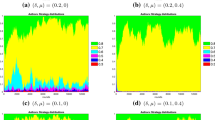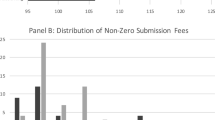Abstract
How much does it cost to publish a research article in a scholarly journal? Different academic publishers have widely varying levels of publication fees to help to fund editorial and peer review administration. In this context, publishers of scientific journals might create author’s ignorance by making the publication fees more complex, thereby gaining power to increase their profits. This paper shows a model of competition between academic journals to publish authors’ manuscripts. Since the low-fees journals want authors to know that they have the lowest publication cost, these journals want fees to be reasonably clear. Adding clarity allows them to undercut their competitors and gain percentage of authors in the field. On the contrary, high-fees journals desire more complexity in the disclosure of author’s costs. We also show that a higher proportion of journals will add complexity to their author’s costs when there is greater journal competition in the research field. In our model, as journal competition increases, the expected number of authors informed about the publication costs in the field may decrease without optimal regulation. On the contrary, if the academy or interest groups in the field add educational initiatives, the expected number of informed authors may still increase as the number of competitor journals grows.
Similar content being viewed by others
References
Bjök, B.-C., & Solomon, D. (2012). Pricing principles used by scholarly open access publishers. Learned Publishing, 25(2), 132–137. https://doi.org/10.1087/20120207.
Bjök, B.-C., & Solomon, D. (2014). Developing an effective market for open access article processing charges. Wellcome Trust; London. https://wellcome.ac.uk/sites/default/files/developing-effective-market-for-open-access-article-processing-charges-mar14.pdf.
Carlin, B. I. (2009). Strategic price complexity in retail financial markets. Journal of Financial Economics, 91(3), 278–287. https://doi.org/10.1016/j.jfineco.2008.05.002.
Dasgupta, P., & Maskin, E. (1986). The existence of equilibrium in discontinuous economic games, I and II: Theory and applications. Review of Economic Studies, 53(1), 1–41. https://doi.org/10.2307/2297588.
Directory of Open Access Journals (DOAJ). https://doaj.org/search.
Eckert, S., Sumner, C., & Krause, T. (2018). Inside the fake science factory. In Presentation at DEF CON 26, Las Vegas, 11 Aug 2018.
Elsevier’s Pricing. (2019). https://www.elsevier.com/about/policies/pricing.
Harvard Open Access Project. (2019) https://cyber.harvard.edu/hoap/How_to_make_your_own_work_open_access.
Hopf, H., Krief, A., Mehta, G., & Matlin, S. A. (2019). Fake science and the knowledge crisis: Ignorance can be fatal. Royal Society Open Science, 6(5), 190161. https://doi.org/10.1098/rsos.190161.
Initiative for Open Citations. (2019). https://i4oc.org/.
Kiley, R. (2013). Colour and page charges: results of a brief survey. Wellcome Trust; London. http://www.researchinfonet.org/wp-content/uploads/2013/09/Wellcome-survey-of-colour-and-page-charges-v-02.pdf.
Larivière, V. (2019). Blog post by Vincent Larivière (Interim Editor, QSS). http://issi-society.org/blog/posts/2019/january/resignation-of-the-editorial-board-of-the-journal-of-informetrics/.
Matlin, S. A., Mehta, G., Krief, A., & Hopf, H. (2017). The scientific publishing conundrum: A perspective from chemistry. Beilstein Magazine. https://doi.org/10.3762/bmag.9.
Nash, J. (1951). Non-cooperative games. The Annals of Mathematics, 54(2), 286–295.
Panter, M. (2019). Understanding Submission and Publication Fees. AJE Scholar, https://www.aje.com/en/arc/understanding-submission-and-publication-fees/?cv=1.
Post-Finch Stakeholder Forum meeting. (2013). Research Information Network. http://www.researchinfonet.org/wp-content/uploads/2013/02/Post-Finch-Forum-mtg-26-03-2013-draft-minutes.pdf.
Socha, B. (2017). How much do top publishers charge for open access?. OpenScience. https://openscience.com/how-much-do-top-publishers-charge-for-open-access/.
Solomon, D. J., & Björk, B.-C. (2012). A study of open access journals using article processing charges. Journal of the American Society for Information Science and Technology, 63(8), 1485–1495. https://doi.org/10.1002/asi.22673.
Springer Open. (2019). https://www.springeropen.com/get-published/article-processing-charges.
Van Noorden, R. (2013). Open access: The true cost of science publishing. Nature, 495, 426–429. https://doi.org/10.1038/495426a.
Acknowledgements
This research was sponsored by the Spanish Board for Science, Technology, and Innovation under grant TIN2017-85542-P, and co-financed with European FEDER funds. Sincere thanks are due to the reviewers for their constructive suggestions.
Author information
Authors and Affiliations
Corresponding author
Appendices
Appendix 1: Proof of Proposition 1
The proof of Proposition 1 follows from results in Carlin (2009). The outline of the arguments used there is as follows. From Eq. (5), the payoff function for each academic journal is continuous, except when its cost to publish a paper is the lowest and the same to one of the other journals. Then, the journal can increase this payoff by lowering their cost to publish a paper. It is possible to show, however, that each journal’s payoff function is indeed weakly lower semi-continuous when its cost is the lowest and equal to at least one of its competitors (Carlin 2009).
Additionally, since the sum of the payoffs to all of the journals in J is a continuous function of any one journal’s cost, the publication cost game satisfies the conditions that are required for the existence of a symmetric mixed-strategy Nash equilibrium as outlined by Dasgupta and Maskin (1986).
It is then possible to show that the optimal complexity choice for each journal only depends on its own publication cost and the distribution of costs that competing journals use to mix over publication costs.
To sum up, the proof is similar to that of Proposition 1 in Carlin (2009). So we skip it in this communication since it is given in its entirety in the Appendix of Carlin (2009).
Appendix 2: Proof of Proposition 3
Again we follow Carlin (2009) to prove Part 1 in the proposition. So, consider that
with \(k_j \in [\underline{k}, \overline{k}]\), and where \(0<\underline{k}< \overline{k}< 1\). It is straightforward to verify that \(\eta\) satisfies the conditions defined in the “publication cost game” section. Let \(\alpha = \overline{k} - \underline{k}\). It follows then from Eq. (7) that \(\eta _{{\text{max}}} - \eta _{{\text{min}}} = \alpha\).
Since each journal’s complexity choice is binary and the probability of adding high complexity is \(\left[ \frac{1}{n}\right] ^{1/(n-1)}\), it follows that the expected fraction of informed authors is computed as:
with m being the number of journals choosing to add high complexity to the disclosure of production costs. Since \(E[ \eta ]\) in Eq. (8) is \(\eta _{{\text{max}}}\) minus the expectation of a binomial variable, it follows that
which is decreasing in n. Consequently, as journal competition n rises, the expected number of informed authors decreases.
We also follow Carlin (2009) to prove Part 2 in the proposition. Now, consider that
with \(k_j \in [\underline{k}, \overline{k}]\), and where \(0<\underline{k}< \overline{k}< 1\). Again \(\eta\) satisfies the conditions defined in the “publication cost game” section, and consider \(\alpha = \overline{k} - \underline{k}\). In this case, we have that \(\eta\) is more sensitive to changes in n than before, because this construction of \(\eta\) captures the idea that the academy or interest groups in the field add educational initiatives for disseminating knowledge, in a fair, open, and transparent way about the publication costs, as the number of journals grows in size.
As before, each journal’s complexity choice is binary and the probability of adding high complexity is \(\left[ \frac{1}{n}\right] ^{1/(n-1)}\). Then, the expected fraction of informed authors is computed as:
where again m is the number of journals choosing to add high complexity to the disclosure of production costs. Therefore, in this case, it follows that the expected fraction of informed authors is
which is now increasing in n. Consequently, as journal competition n rises, the expected number of informed authors increases, despite the increased tendency for academic journals to add complexity to the disclosure of publication costs.
Rights and permissions
About this article
Cite this article
García, J.A., Rodriguez-Sánchez, R., Fdez-Valdivia, J. et al. The author’s ignorance on the publication fees is a source of power for publishers. Scientometrics 121, 1435–1445 (2019). https://doi.org/10.1007/s11192-019-03231-8
Received:
Published:
Issue Date:
DOI: https://doi.org/10.1007/s11192-019-03231-8




